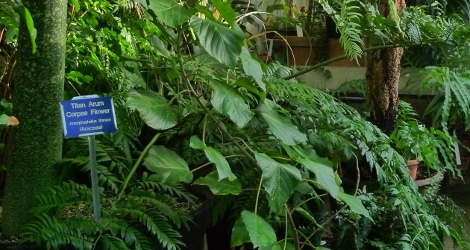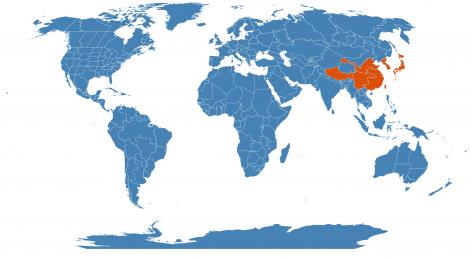Accession Data:
Hemerocallis fulva (L.) L.
- Common Name: Daylily
- Family: Asphodelaceae
- Description: Hemerocallis fulva is an infertile triploid that does not set seed. It spreads by rhizomes. If left unattended, it can form large colonies and is considered an invasive in many areas.
- Uses: Medicinal: Diuretic, febrifuge, laxative (mild)[62, 178, 205]. The flowers are anodyne, antiemetic, antispasmodic, depurative, febrifuge and sedative[218]. In China they are used as an anodyne for women in childbirth[240]. An extract of the flowers is used as a blood purifier[240]. The rhizome has shown antimicrobial acivity, it is also tuberculostatic and has an action against the parasitic worms that cause filariasis[279]. It is used in Korea to treat oppilation, jaundice, constipation and pneumonia[279]. The juice of the roots is an effective antidote in cases of arsenic poisoning[205]. The root also has a folk history of use in the treatment of cancer - extracts from the roots have shown antitumour activity[218]. A tea made from the boiled roots is used as a diuretic[205, 218]. (Plants For A Future)
Edible:Leaves and young shoots - cooked[85, 116, 179, 183]. An asparagus or celery substitute. An excellent sweet tasting vegetable[179, K], though some caution is recommended[127, 137]. The leaves need to be eaten whilst still very young since they quickly become fibrous[K]. Flowers - raw or cooked[62, 100]. The petals are thick and crunchy, making very pleasant eating raw, with a nice sweetness at the base because of the nectar[K]. The flowers can also be dried and used as a thickener in soups etc[62, 183]. In this case, they are picked when somewhat withered and closed[85]. A rich source of iron[218]. Flower buds - raw or cooked[62, 100, 105, 116]. A pea-like flavour[85]. Can be dried and used as a relish[178]. The dried flower contains about 9.3% protein. 25% fat!?, 60% carbohydrate (rich in sugar), 0.9% ash. It is rich in vitamin A[179]. Tubers - raw or cooked[183]. A nutty flavour[62]. Young tubers are best, though the central portion of older tubers is also good[85].
- IMPORTANT NOTE: Plant Uses are for informational purposes only. EEB Greenhouses assume no responsibility for adverse effects from the use of any plants referred to on this site. Always seek advice from a professional before using any plant medicinally.
- USDA Zone: 5a-10b
Accession Data:
- Accession # 199900059
- Source: Steinbachs - EEB
- Accession Date: 06-07-1999
- Bench: 5000 - Garden - TBD
- Currently: active - healthy
- Qty: 1 confirmed on 06-30-2024
- Restrictions:
- Poisonous Plant Parts - Not for Human Consumption
Large quantities can be harmful. - Potentially Invasive Plant - Plants are not to leave Greenhouse!
- Poisonous Plant Parts - Not for Human Consumption
Classification:
- Division: Magnoliophyta
- Class: Liliopsida
- SubClass: monocots
- Order: Asparagales
- SubOrder:
- Family: Asphodelaceae
- SubFamily: Hemerocallidoideae
- Tribe:
- SubTribe:
Flowering Data:
This accession has been observed in bloom on:| Year | Jan | Feb | Mar | Apr | May | Jun | Jul | Aug | Sep | Oct | Nov | Dec | ||||||||||||||||||||||||||||||||||||||||
|---|---|---|---|---|---|---|---|---|---|---|---|---|---|---|---|---|---|---|---|---|---|---|---|---|---|---|---|---|---|---|---|---|---|---|---|---|---|---|---|---|---|---|---|---|---|---|---|---|---|---|---|---|
| 2025 | ||||||||||||||||||||||||||||||||||||||||||||||||||||
| 2024 | ||||||||||||||||||||||||||||||||||||||||||||||||||||
| 2023 | ||||||||||||||||||||||||||||||||||||||||||||||||||||
| 2022 | ||||||||||||||||||||||||||||||||||||||||||||||||||||
| 2021 | ||||||||||||||||||||||||||||||||||||||||||||||||||||
| 2020 | ||||||||||||||||||||||||||||||||||||||||||||||||||||
| 2019 | ||||||||||||||||||||||||||||||||||||||||||||||||||||
| 2018 | ||||||||||||||||||||||||||||||||||||||||||||||||||||
| 2017 | ||||||||||||||||||||||||||||||||||||||||||||||||||||
| 2016 | ||||||||||||||||||||||||||||||||||||||||||||||||||||
| 2015 | ||||||||||||||||||||||||||||||||||||||||||||||||||||
| 2014 | ||||||||||||||||||||||||||||||||||||||||||||||||||||
| 2013 | ||||||||||||||||||||||||||||||||||||||||||||||||||||
| 2012 | ||||||||||||||||||||||||||||||||||||||||||||||||||||
| 2011 | ||||||||||||||||||||||||||||||||||||||||||||||||||||
| 2010 | ||||||||||||||||||||||||||||||||||||||||||||||||||||
| 2009 | ||||||||||||||||||||||||||||||||||||||||||||||||||||
| 2008 | ||||||||||||||||||||||||||||||||||||||||||||||||||||
| 2007 | ||||||||||||||||||||||||||||||||||||||||||||||||||||
| 2006 | ||||||||||||||||||||||||||||||||||||||||||||||||||||
| 2005 | ||||||||||||||||||||||||||||||||||||||||||||||||||||
| 2004 | ||||||||||||||||||||||||||||||||||||||||||||||||||||
References (internal):
- EEB Greenhouse Holdings native to: China South-Central / China North-Central / China Southeast / Tibet / Japan / Korea / Taiwan /
References (external):
- The Plant List (2013). Version 1.1. Accessed 24 February 2015.
- WCSP (2015). World Checklist of Selected Plant Families. Facilitated by the Royal Botanic Gardens, Kew. Accessed 24 February 2015.
- Angiosperm Phylogeny Website at MoBot. Last accessed on Tuesday, 03 December, 2019.
data regenerated on Tue, 06 May 2025 11:09:04 -0400 [bcm v4.0]
Images:

Additional images for this accession:
Click on thumbnails to enlargeCurrent Accessions in the Asphodelaceae
Subfamily Asphodeloideae
- Aloe albiflora

- Aloe alooides

- Aloe arborescens

- Aloe bakeri

- Aloe berevoana W/C

- Aloe branddraaiensis W/C

- Aloe burgersfortensis

- Aloe cooperi W/C

- Aloe cremnophila

- Aloe descoingsii

- Aloe dorotheae

- Aloe ferox

- Aloe globuligemma W/C

- Aloe jucunda

- Aloe juvenna

- Aloe krapohliana

- Aloe longistyla


- Aloe maculata

- Aloe marlothii W/C

- Aloe melanacantha

- Aloe nobilis
- Aloe parvula


- Aloe polyphylla

- Aloe rauhii

- Aloe rivierei

- Aloe spicata

- Aloe thraskii

- Aloe vera


- Aloe vogtsii

- Aloiampelos ciliaris

- Aristaloe aristata

- Asphodeline liburnica

- Astroloba congesta

- Bulbine frutescens

- Bulbine margarethae W/C

- x Gasterhaworthia Royal Highness
- Gasteria batesiana


- Gasteria brachyphylla W/C

- Gasteria brachyphylla var. bayeri

- Gasteria disticha W/C

- Gasteria ellaphieae

- Gasteria glauca W/C

- Gasteria glomerata


- Gasteria nitida var. armstrongii

- Gasteria obliqua


- Gonialoe variegata

- Haworthia attenuata var. radula


- Haworthia blackburniae


- Haworthia cf. aristata W/C

- Haworthia cooperi W/C

- Haworthia cooperi var. dielsiana

- Haworthia cooperi var. truncata W/C

- Haworthia cymbiformis


- Haworthia cymbiformis


- Haworthia gracilis var. tenera

- Haworthia pygmaea var. acuminata W/C

- Haworthia magnifica var. splendens W/C


- Haworthia marumiana var. batesiana

- Haworthia mirabilis W/C

- Haworthia mirabilis var. paradoxa

- Haworthia mirabilis var. triebneriana

- Haworthia retusa


- Haworthia retusa W/C


- Haworthia truncata


- Haworthia truncata W/C


- Haworthia turgida

- Haworthia venosa subsp. tessellata
- Haworthiopsis glauca

- Haworthiopsis limifolia W/C

- Haworthiopsis limifolia W/C

- Haworthiopsis limifolia W/C

- Haworthiopsis longiana

- Haworthiopsis reinwardtii

- Haworthiopsis viscosa W/C


- Kumara plicatilis


Subfamily Hemerocallidoideae
Subfamily Xanthorrhoeoideae
W/C = Wild Collected = indicates flowering in past 14 days
= indicates flowering in past 14 days
 = images available for this accession
= images available for this accession
 = map available for this accession
= map available for this accession
 = accession added within past 90 days
= accession added within past 90 days

